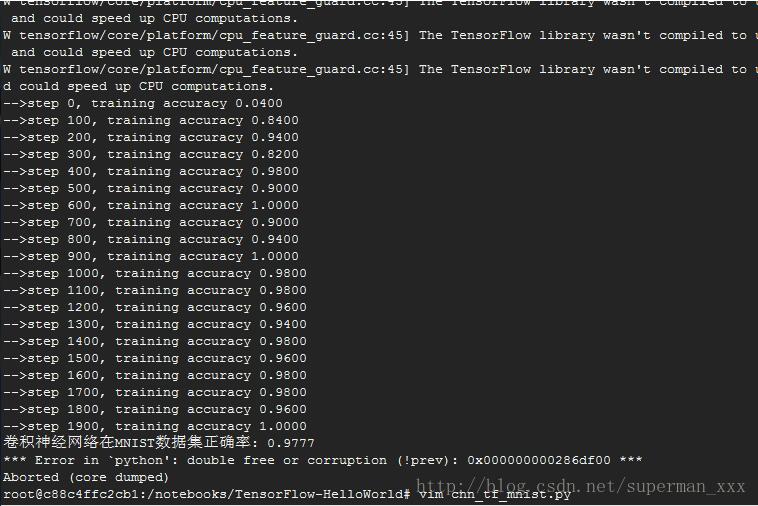本文实例为大家分享了TensorFlow实现卷积神经网络的具体代码,供大家参考,具体内容如下
代码(源代码都有详细的注释)和数据集可以在github下载:
# -*- coding: utf-8 -*-
'''卷积神经网络测试MNIST数据'''
#########导入MNIST数据########
from tensorflow.examples.tutorials.mnist import input_data
import tensorflow as tf
mnist = input_data.read_data_sets('MNIST_data/', one_hot=True)
# 创建默认InteractiveSession
sess = tf.InteractiveSession()
#########卷积网络会有很多的权重和偏置需要创建,先定义好初始化函数以便复用########
# 给权重制造一些随机噪声打破完全对称(比如截断的正态分布噪声,标准差设为0.1)
def weight_variable(shape):
initial = tf.truncated_normal(shape, stddev=0.1)
return tf.Variable(initial)
# 因为我们要使用ReLU,也给偏置增加一些小的正值(0.1)用来避免死亡节点(dead neurons)
def bias_variable(shape):
initial = tf.constant(0.1, shape=shape)
return tf.Variable(initial)
########卷积层、池化层接下来重复使用的,分别定义创建函数########
# tf.nn.conv2d是TensorFlow中的2维卷积函数
def conv2d(x, W):
return tf.nn.conv2d(x, W, strides=[1, 1, 1, 1], padding='SAME')
# 使用2*2的最大池化
def max_pool_2x2(x):
return tf.nn.max_pool(x, ksize=[1, 2, 2, 1],strides=[1, 2, 2, 1], padding='SAME')
########正式设计卷积神经网络之前先定义placeholder########
# x是特征,y_是真实label。将图片数据从1D转为2D。使用tensor的变形函数tf.reshape
x = tf.placeholder(tf.float32, shape=[None, 784])
y_ = tf.placeholder(tf.float32, shape=[None, 10])
x_image = tf.reshape(x,[-1,28,28,1])
########设计卷积神经网络########
# 第一层卷积
# 卷积核尺寸为5*5,1个颜色通道,32个不同的卷积核
W_conv1 = weight_variable([5, 5, 1, 32])
# 用conv2d函数进行卷积操作,加上偏置
b_conv1 = bias_variable([32])
# 把x_image和权值向量进行卷积,加上偏置项,然后应用ReLU激活函数,
h_conv1 = tf.nn.relu(conv2d(x_image, W_conv1) + b_conv1)
# 对卷积的输出结果进行池化操作
h_pool1 = max_pool_2x2(h_conv1)
# 第二层卷积(和第一层大致相同,卷积核为64,这一层卷积会提取64种特征)
W_conv2 = weight_variable([5, 5, 32, 64])
b_conv2 = bias_variable([64])
h_conv2 = tf.nn.relu(conv2d(h_pool1, W_conv2) + b_conv2)
h_pool2 = max_pool_2x2(h_conv2)
# 全连接层。隐含节点数1024。使用ReLU激活函数
W_fc1 = weight_variable([7 * 7 * 64, 1024])
b_fc1 = bias_variable([1024])
h_pool2_flat = tf.reshape(h_pool2, [-1, 7*7*64])
h_fc1 = tf.nn.relu(tf.matmul(h_pool2_flat, W_fc1) + b_fc1)
# 为了防止过拟合,在输出层之前加Dropout层
keep_prob = tf.placeholder(tf.float32)
h_fc1_drop = tf.nn.dropout(h_fc1, keep_prob)
# 输出层。添加一个softmax层,就像softmax regression一样。得到概率输出。
W_fc2 = weight_variable([1024, 10])
b_fc2 = bias_variable([10])
y_conv=tf.nn.softmax(tf.matmul(h_fc1_drop, W_fc2) + b_fc2)
########模型训练设置########
# 定义loss function为cross entropy,优化器使用Adam,并给予一个比较小的学习速率1e-4
cross_entropy = tf.reduce_mean(-tf.reduce_sum(y_*tf.log(y_conv),reduction_indices=[1]))
train_step = tf.train.AdamOptimizer(1e-4).minimize(cross_entropy)
# 定义评测准确率的操作
correct_prediction = tf.equal(tf.argmax(y_conv,1), tf.argmax(y_,1))
accuracy = tf.reduce_mean(tf.cast(correct_prediction, tf.float32))
########开始训练过程########
# 初始化所有参数
tf.global_variables_initializer().run()
# 训练(设置训练时Dropout的kepp_prob比率为0.5。mini-batch为50,进行2000次迭代训练,参与训练样本5万)
# 其中每进行100次训练,对准确率进行一次评测keep_prob设置为1,用以实时监测模型的性能
for i in range(1000):
batch = mnist.train.next_batch(50)
if i%100 == 0:
train_accuracy = accuracy.eval(feed_dict={x:batch[0], y_: batch[1], keep_prob: 1.0})
print "-->step %d, training accuracy %.4f"%(i, train_accuracy)
train_step.run(feed_dict={x: batch[0], y_: batch[1], keep_prob: 0.5})
# 全部训练完成之后,在最终测试集上进行全面测试,得到整体的分类准确率
print "卷积神经网络在MNIST数据集正确率: %g"%accuracy.eval(feed_dict={
x: mnist.test.images, y_: mnist.test.labels, keep_prob: 1.0})

以上就是本文的全部内容,希望对大家的学习有所帮助,也希望大家多多支持亿速云。
亿速云「云服务器」,即开即用、新一代英特尔至强铂金CPU、三副本存储NVMe SSD云盘,价格低至29元/月。点击查看>>
免责声明:本站发布的内容(图片、视频和文字)以原创、转载和分享为主,文章观点不代表本网站立场,如果涉及侵权请联系站长邮箱:is@yisu.com进行举报,并提供相关证据,一经查实,将立刻删除涉嫌侵权内容。